Sustainable manufacturing innovation in Europe
Labour shortage, the skills gap and the daily hunt for talent are truths universally acknowledged in the manufacturing industry and beyond. But what do these aspects actually mean for sustainable manufacturing innovation? And what can we do to change the situation?
The EIT Manufacturing Summit 2023 dedicated time and space to these topics in the Maison de la Poste in Brussels. Welcoming an audience from politics, academia, industry and start-ups, conversations on stage revealed the complexity and interconnectedness of challenges and opportunities in this field.
This article collects key thoughts that were mentioned in the event – please feel free to take them up directly in conversations with the speakers on LinkedIn!
Setting the scene
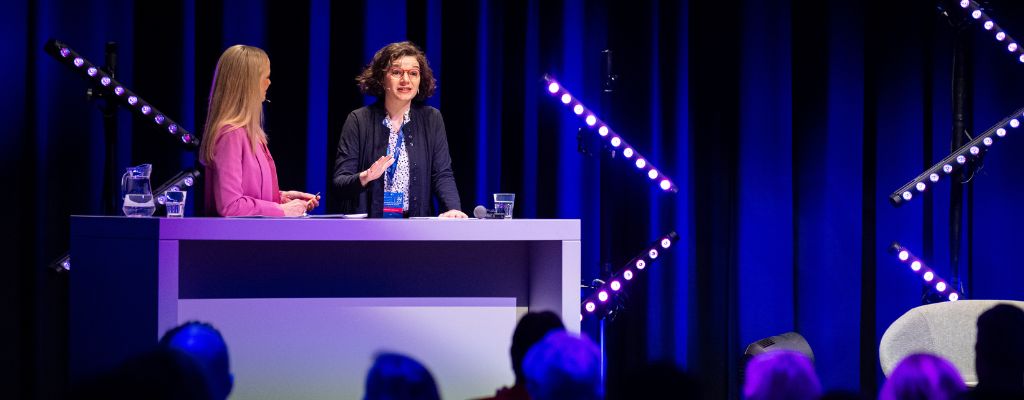 Journalist and TV host Karin Helmstaedt opened the EIT Manufacturing Summit together with Caroline Viarouge, who has led EIT Manufacturing as a CEO since May 2023. In her new role, Caroline Viarouge travelled the offices in the six regions of the company to listen and learn.
Journalist and TV host Karin Helmstaedt opened the EIT Manufacturing Summit together with Caroline Viarouge, who has led EIT Manufacturing as a CEO since May 2023. In her new role, Caroline Viarouge travelled the offices in the six regions of the company to listen and learn.
Labour shortage, she said, was one of the key aspects felt by everybody across the ecosystem. She also saw the will to transform towards more sustainability, but great helplessness on how and where to start. Investment was needed in green technologies in parallel to education of staff, but resources were finite.
As a result of her visits, Caroline Viarouge set to work on the EIT Manufacturing strategy, reworking it together with the management team, the supervisory board and core partners. “After four years, the context of the Strategic Agenda has simply changed,” she said. There were multiple challenges, such as the aging population that stood opposite technological changes at exponential pace, or the need to change from a linear production with massive loss of raw material to a circular economy which required a different skill- and mindset.
 “A winning team dares to innovate and challenge the status quo”
“A winning team dares to innovate and challenge the status quo”
Co-creation and collaboration as well as getting more women into manufacturing were ways Caroline Viarouge advocated to secure the necessary talent for sustainable manufacturing. “We believe in people-centric innovation, the power of diversity and women in manufacturing,” she said, before encouraging the audience to take the opportunity to build new collaborations at the EIT Manufacturing Summit.
“What you foresee is what you get”
 Opening the audience’s minds, Tamara Carleton, an award-winning professor, industry advisor and globally recognised expert in “radical innovations” as well as CEO of the Innovation Leadership Group, took a stand for moonshots.
Opening the audience’s minds, Tamara Carleton, an award-winning professor, industry advisor and globally recognised expert in “radical innovations” as well as CEO of the Innovation Leadership Group, took a stand for moonshots.
Moonshots, she explained, were big ideas which had big impact and dated back to John F. Kennedy’s explanation of why he wanted Americans to go to the moon. They required time and money, but most of all imagination, which could be sparked by asking “What if?”. “Imagining a better future is the first step in building the solutions that will define it,” she stated and gave examples from Germany testing the idea of an electric highway and the American ARPA-H initiative which brought the impossible into focus concerning health challenges.
Opening roundtable

Directing the focus to the need for talent in Europe, Karin Helmstaedt asked representatives of the European Commission, the European Innovation Council (EIC) and the European Institute of Innovation and Technology (EIT) their views on the skills gap.
 Antoaneta Angelova-Krasteva, Director of Innovation, Digital Education and International Cooperation at Directorate-General for Education, Youth, Sport and Culture of the European Commission, called the European Year of Skills a fantastic opportunity to address the skills gap which, she mentioned, was felt by two thirds of European companies. She pointed to the need of politics and industry to work together to realise education and training in the framework set by initiatives such as the New European Innovation Agenda or the Net-Zero Industry Act. As an example, she mentioned the EIT Deep Tech Talent Initiative, which is coordinated by EIT Manufacturing, and targets to skill one million people within deep the fields over the next three years.
Antoaneta Angelova-Krasteva, Director of Innovation, Digital Education and International Cooperation at Directorate-General for Education, Youth, Sport and Culture of the European Commission, called the European Year of Skills a fantastic opportunity to address the skills gap which, she mentioned, was felt by two thirds of European companies. She pointed to the need of politics and industry to work together to realise education and training in the framework set by initiatives such as the New European Innovation Agenda or the Net-Zero Industry Act. As an example, she mentioned the EIT Deep Tech Talent Initiative, which is coordinated by EIT Manufacturing, and targets to skill one million people within deep the fields over the next three years.
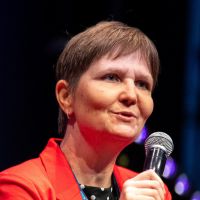
Malgorzata Nikowska, Head of the Digital Transformation of Industrial Ecosystems Unit of the Directorate-General for Communications Networks, Content and Technology of the European Commission, elaborated on the role of the European Digital Innovation Hubs (EDIHs) in realising the Digital Transformation. After assessing the digital maturity of a company, more than 230 EDIHs offer support with networking, financing, skills development and a test before invest phase which, according to Malgorzata Nikowska made all the difference. As examples she named an organic two-person farm in Lithuania that went from using Excel spreadsheets to thinking about robotisation, a theatre that developed a dashboard to optimise construction of stage sets and a Portuguese clothes company which became all the rage after adapting an app from a different industry to customise their products.

The public-private partnership programme Made in Europe under Horizon Europe uses a different lever to promote skills, said Nicholas Deliyanakis, Policy Coordinator of the Industrial Transformation Unit of the Directorate-General Research & Development of the European Commission. As the projects supported under Made in Europe enable aspects such as excellence, circularity, manufacturing-as-a-service, they give companies tools with which they can work better. While Made in Europe was not an educational programme itself, it encourages the project to develop curricula for upskilling workers. He gave the example of developing workers’ skills when solutions using artificial intelligence are introduced on the shopfloor.
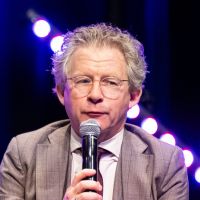
As part of Horizon Europe and the world biggest technology fund, explained Michiel Scheffer, President of the Board of the European Innovation Council (EIC), the EIT aimed to back entrepreneurship. Yet the focus was not only on funding entrepreneurs with a variety of programmes with different focus, such as pathfinder, accelerator and transition programmes, alone, but also on training and making connections to keep talent and skills within Europe.
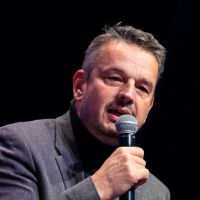 Heinrich Arnold, Governing Board Member, European Institute of Innovation & Technology (EIT), put training into the context of European economic history. In Europe, he pointed out, companies had always been good at reinventing themselves. He mentioned that, on average, European companies were 1920 years old, many even founded in the 1870s, and that today, only one percent of jobs was created by start-ups in Europe compared to the United State of America, where this figure was at ten percent.
Heinrich Arnold, Governing Board Member, European Institute of Innovation & Technology (EIT), put training into the context of European economic history. In Europe, he pointed out, companies had always been good at reinventing themselves. He mentioned that, on average, European companies were 1920 years old, many even founded in the 1870s, and that today, only one percent of jobs was created by start-ups in Europe compared to the United State of America, where this figure was at ten percent.
In a wrap-up, the speakers elaborated on the key challenges in Europe. For Antoaneta Angelova-Krasteva, the structural differences in different regions are as big a challenge as the lack of women in manufacturing. Malgorzata Nikowska pointed to the multitude of initiatives on the one hand – rather than issuing yet another initiative, they should be allowed the time to grow and mature – and on the other hand to the need for flexibility – since we did not know tomorrow’s challenges for certain, adaptability was called for.

Nicholas Deliyanakis viewed ageing as the biggest challenge and encouraged re-thinking manufacturing processes, considering both physical and cognitive aspects. Michiel Scheffer reminded the audience that time, or the lack there-of, was a crucial factor and gave the example of the ERASMUS projects that had started 36 years ago and only taken off slowly.
Roundtable: Sustainable and future-proof innovation for competitive European manufacturing

The conversation on “Sustainable and future-proof innovation for competitive European manufacturing” brought together industry experts and start-up as well as project representatives from the EIT Manufacturing community.
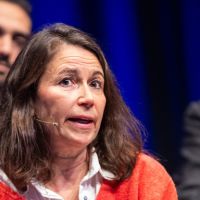 Robin Teigland, Professor of Strategy and Digitalization at Chalmers University of Technology, sees a clear need for more informal learning and more diverse networks as we tended to network with people who thought alike. Companies could use the PESTEL model, short for political, economic, social, technological, environmental and legal, to analyse their networks. For innovation to flourish, she advocated, we should keep our minds open and humans at the centre. She also observed that entrepreneurship was a tough business since investors looked for scalability. Her own company, which sourced locally and produced for regional markets, was not scalable, she said, so she financed the endeavour with her own money.
Robin Teigland, Professor of Strategy and Digitalization at Chalmers University of Technology, sees a clear need for more informal learning and more diverse networks as we tended to network with people who thought alike. Companies could use the PESTEL model, short for political, economic, social, technological, environmental and legal, to analyse their networks. For innovation to flourish, she advocated, we should keep our minds open and humans at the centre. She also observed that entrepreneurship was a tough business since investors looked for scalability. Her own company, which sourced locally and produced for regional markets, was not scalable, she said, so she financed the endeavour with her own money.
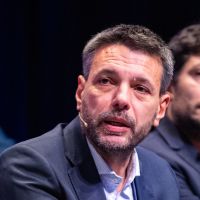 Fernando Sanchez Troncoso, R&D Director of AIMEN, gave testimony of the importance of networks – AIMEN had built research facilities to develop, test and validate solutions for the industry. This started for various research projects. When they opened the facilities for different industry players, this worked very well. In the meantime, he said, they had a network of regional factories sharing the facilities as well as human resources.
Fernando Sanchez Troncoso, R&D Director of AIMEN, gave testimony of the importance of networks – AIMEN had built research facilities to develop, test and validate solutions for the industry. This started for various research projects. When they opened the facilities for different industry players, this worked very well. In the meantime, he said, they had a network of regional factories sharing the facilities as well as human resources.
 For Eleonora Brighenti, Head of Sustainable Innovation, DANA Incorporated, a change of mindset is needed in corporations. Implementing brand new technologies required technical skills just as much as softs skills. Knowledge from outside the company needed to be integrated and this process took time. She calls innovation a journey and sustainability a destination. From her perspective, innovation must permeate an entire company and gain community dimension. She emphasises that entrepreneurial spirit was needed to lead this change.
For Eleonora Brighenti, Head of Sustainable Innovation, DANA Incorporated, a change of mindset is needed in corporations. Implementing brand new technologies required technical skills just as much as softs skills. Knowledge from outside the company needed to be integrated and this process took time. She calls innovation a journey and sustainability a destination. From her perspective, innovation must permeate an entire company and gain community dimension. She emphasises that entrepreneurial spirit was needed to lead this change.
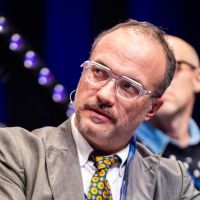 Ionut Tata, CEO of Iceberg Plus, pointed out that innovation often happened as a reaction, as we had seen during COVID-19. Business leaders were unsure of what would be coming next and while they knew how to work with territories and people, they still needed to come to terms with new technologies. There were a number of questions we did not know the answers to, such as, would we have industrial growth without an increase in jobs or how exactly would we achieve a cradle-to-cradle industry if money was missing to invest into the circular economy.
Ionut Tata, CEO of Iceberg Plus, pointed out that innovation often happened as a reaction, as we had seen during COVID-19. Business leaders were unsure of what would be coming next and while they knew how to work with territories and people, they still needed to come to terms with new technologies. There were a number of questions we did not know the answers to, such as, would we have industrial growth without an increase in jobs or how exactly would we achieve a cradle-to-cradle industry if money was missing to invest into the circular economy.
Some answers to specific challenges came from start-up and project representatives from the EIT Manufacturing community.
 Sander Trofimov, Production Manager at UP Catalyst, representing the project MoReCCU, confirmed the need for soft skills in innovation. The skills gap in engineering, to him, can be overcome, but tapping into knowledge that was already there, was crucial. He sees this before the background of a project that transforms linear manufacturing to circular manufacturing by turning CO2 from the heavy industry into carbon nanomaterials and graphite. The latter is a critical raw material in the EU as it cannot be sourced locally.
Sander Trofimov, Production Manager at UP Catalyst, representing the project MoReCCU, confirmed the need for soft skills in innovation. The skills gap in engineering, to him, can be overcome, but tapping into knowledge that was already there, was crucial. He sees this before the background of a project that transforms linear manufacturing to circular manufacturing by turning CO2 from the heavy industry into carbon nanomaterials and graphite. The latter is a critical raw material in the EU as it cannot be sourced locally.
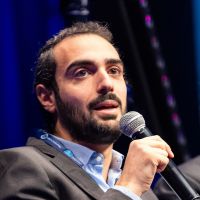 Also, raw materials for battery production need to be imported from outside of the EU – a challenge, especially considering that with increasing amounts of e-mobility, there are more batteries on the market which cannot be re-used. The project Flex-BD, presented by Francesco Beccarisi from Comau, is working on an automised system in which batteries can be dismantled. The complexity of the task comes from the flexibility needed as batteries come in various shapes, sizes and setups.
Also, raw materials for battery production need to be imported from outside of the EU – a challenge, especially considering that with increasing amounts of e-mobility, there are more batteries on the market which cannot be re-used. The project Flex-BD, presented by Francesco Beccarisi from Comau, is working on an automised system in which batteries can be dismantled. The complexity of the task comes from the flexibility needed as batteries come in various shapes, sizes and setups.
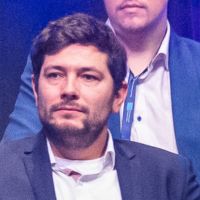 Robert Hellbach, Research Scientist at BIBA – Bremer Institut für Produktion und Logistik GmbH, also focuses on energy, facilitating an energy-aware mindset in employees. The project SmartPower is an educational project that provides knowledge of two industry4.0 application domains – namely smart manufacturing and smart micro grids.
Robert Hellbach, Research Scientist at BIBA – Bremer Institut für Produktion und Logistik GmbH, also focuses on energy, facilitating an energy-aware mindset in employees. The project SmartPower is an educational project that provides knowledge of two industry4.0 application domains – namely smart manufacturing and smart micro grids.
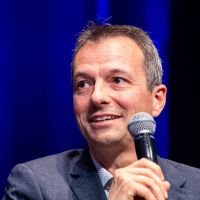 Dominique Mercier, Co-founder & CEO at kheoos, is on a mission to eradicate the wasteful destruction of spare parts and thus decrease CO2 emissions while saving millions of euros. kheoos is a marketplace for industrial maintenance parts which bridges industry needs with industry stock – making the destruction of unused, but unneeded spare parts obsolete.
Dominique Mercier, Co-founder & CEO at kheoos, is on a mission to eradicate the wasteful destruction of spare parts and thus decrease CO2 emissions while saving millions of euros. kheoos is a marketplace for industrial maintenance parts which bridges industry needs with industry stock – making the destruction of unused, but unneeded spare parts obsolete.
He spoke about a policy in Michelin which encourages circularity as a mindset in employees: If a spare part was needed, staff was called upon to first find it internally, if it was not available internally, to buy it second hand, and only if it was not available second-hand, they could buy it new. For policymakers, he suggested the carrot and stick approach – he advocated officially banning the destruction of spare parts combined with an incentive for buying parts from stock.
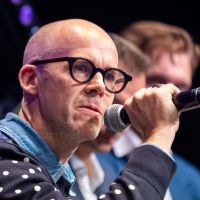 Also the startup STILRIDE is bent on saving material. Taking inspiration from nature, they use advanced robotics and fold with curves to achieve greater lightness, reduce material and even parts. Jonas Nyvang, Founder and CEO at STILRIDE, even encouraged to feel the technology which they call industrial origami, by standing up and bending backwards.
Also the startup STILRIDE is bent on saving material. Taking inspiration from nature, they use advanced robotics and fold with curves to achieve greater lightness, reduce material and even parts. Jonas Nyvang, Founder and CEO at STILRIDE, even encouraged to feel the technology which they call industrial origami, by standing up and bending backwards.
 Daniel Krob, President at Systemic Intelligence, solves different complexities in the project SYDITIL. It focuses on the use of digital twins for industrial logistics, taking into account economical, environmental, technical and legal data. He gave the example of turning the port of Dunkirk from a coal port to a passenger-focused port, exchanging coal logistics for people logistics and thus facing totally different requirements.
Daniel Krob, President at Systemic Intelligence, solves different complexities in the project SYDITIL. It focuses on the use of digital twins for industrial logistics, taking into account economical, environmental, technical and legal data. He gave the example of turning the port of Dunkirk from a coal port to a passenger-focused port, exchanging coal logistics for people logistics and thus facing totally different requirements.
 Balázs Barta, Managing Director at Panon Business Network, spoke about the project DigiTwinGreen and the need to make the Green and Digital Transition tangible and understandable to everybody. The European Digital Innovation Hub and the RIS Hub motivated the project to set up a teaching and learning factory focusing on digital twins to recycling models and simulations.
Balázs Barta, Managing Director at Panon Business Network, spoke about the project DigiTwinGreen and the need to make the Green and Digital Transition tangible and understandable to everybody. The European Digital Innovation Hub and the RIS Hub motivated the project to set up a teaching and learning factory focusing on digital twins to recycling models and simulations.
Manufacturing talent
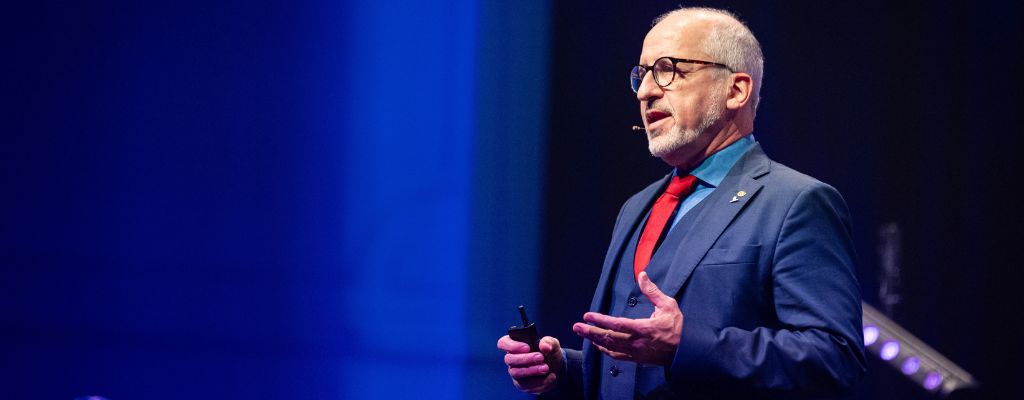
Johan Stahre, Professor at Chalmers University of Technology and Vice-Chair or the EIT Manufacturing Supervisory Board, took the audience back to when talent was still – literally – a currency. Nowadays, he said, talent needed to be matched to a task to have a value, and this no longer referred to an individual talent, but to a talent ecosystem.
Up-skilling and re-skilling needed to happen within the context of an aging and diminishing working population. This was a reality in Europe, China, to a lesser degree in the US, but not in India and Africa. Johan Stahre advised to take stock of the knowledge we already have, motivate pupils to engage in science, technology, engineering and mathematics (STEM) from an early age and specifically diversify and integrate women into manufacturing. His reading recommendation: The Global Gender Gap Report 2023, published by the World Economic Forum.
Migration, he said, did not necessarily have to happen physically, but could be digital, with people working remotely. Cognitive and physical augmentation with devices such as exoskeletons could turn people into superpersons.
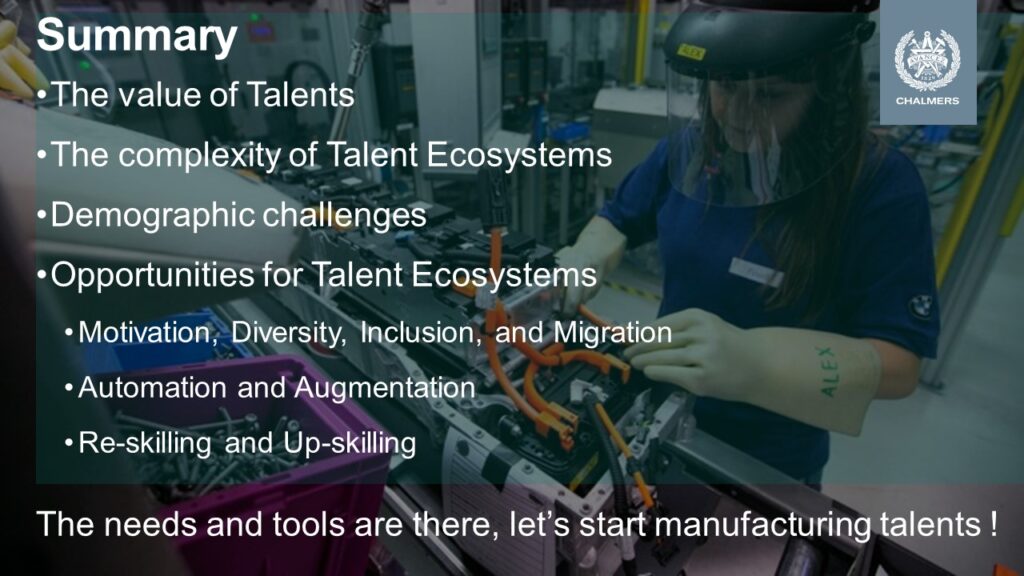
Overall, he painted a positive picture. The need for talent, he said, was certainly there. And we were ready for up-skilling and re-skilling, he said – policy makers had created the framework, the industry was ready and people were, too. In his opinion, also the tools were available – we only needed to start.
Roundtable: Human-Centered Manufacturing: Deep Tech Talent at the Heart of European Innovation

Vanessa Wainright, Founder of education marketplace Abodoo, complemented this saying everybody was called upon to source and develop talent differently to bridge the skills gap. She is concerned that learning should be available to everyone and mentioned that it did not necessarily need to come in the form of a four-year degree. She emphasised that hard skills were as important as softs skills, giving problem solving and critical thinking as an example. At the same time, navigating courses on offer was hard – nowadays, there was so much choice people did not know where to start.
complemented this saying everybody was called upon to source and develop talent differently to bridge the skills gap. She is concerned that learning should be available to everyone and mentioned that it did not necessarily need to come in the form of a four-year degree. She emphasised that hard skills were as important as softs skills, giving problem solving and critical thinking as an example. At the same time, navigating courses on offer was hard – nowadays, there was so much choice people did not know where to start.
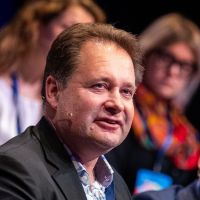 As Head of Lifelong Learning of the Volvo Group, Fredrik Elieson drew attention to the fact that individuals themselves were the key driving force behind upskilling, reskilling and lifelong learning. He views curiosity as a prerequisite: “With curious people, you can always do something.” For companies, he remarked, it was hard to say what skills would be needed in the next years, as technologies were developing so fast. But no public ecosystem, university, company could solve the skills gap without the people who are willing to be educated.
As Head of Lifelong Learning of the Volvo Group, Fredrik Elieson drew attention to the fact that individuals themselves were the key driving force behind upskilling, reskilling and lifelong learning. He views curiosity as a prerequisite: “With curious people, you can always do something.” For companies, he remarked, it was hard to say what skills would be needed in the next years, as technologies were developing so fast. But no public ecosystem, university, company could solve the skills gap without the people who are willing to be educated.
 Gerard Dominguez, Head of EIT Campus in EIT Urban Mobility, underlined the necessity to collaborate. The EIT Campus gives access to training courses across the expertise areas of the different Knowledge and Innovation Centres of the European Institute of Innovation and Technology. It thus aims at breaking silos, as skills may apply to various sectors. There were courses for different levels of background knowledge, designed to fit between work, life and family time.
Gerard Dominguez, Head of EIT Campus in EIT Urban Mobility, underlined the necessity to collaborate. The EIT Campus gives access to training courses across the expertise areas of the different Knowledge and Innovation Centres of the European Institute of Innovation and Technology. It thus aims at breaking silos, as skills may apply to various sectors. There were courses for different levels of background knowledge, designed to fit between work, life and family time.
 Diana Filip, Deputy CEO of JA Europe, illustrated that education needed something more than courses: at eight years old, her son surprised her by announcing he wanted to become a YouTuber. From this, she learned that, from an early age, children need to be exposed to work, so that they develop ideas of what they can become. JA stands for Junior Achievements and has existed for more than 100 years. Now they had started to work together with 35 influencers to spread messages about education on top of their other activities.
Diana Filip, Deputy CEO of JA Europe, illustrated that education needed something more than courses: at eight years old, her son surprised her by announcing he wanted to become a YouTuber. From this, she learned that, from an early age, children need to be exposed to work, so that they develop ideas of what they can become. JA stands for Junior Achievements and has existed for more than 100 years. Now they had started to work together with 35 influencers to spread messages about education on top of their other activities.
For each euro spent on going into schools, she counted out, the community got back 45 euro, with enormous side-effects. Pupils became financially literate, learnt how to manage stakeholders, got better training, better careers, earned more money and volunteered to train others.
She also shared that she was impressed with the experiences from the Green Manufacturing Award that EIT Manufacturing and JA Europe awarded for the first time in 2023. With 240 applications for the award in 2023, this category outperformed the fashion and AI award categories.
 ReBuild was one of the winning projects, presented live by Mathias Happle Sørensen. Inspired by an online platform for reselling clothes, the ReBuild creators translated this concept to the construction industry. They addressed the fact that the construction industry was a major emitter of CO2, also because surplus materials were rather thrown away than used. The ReBuild platform enables easy access to these materials.
ReBuild was one of the winning projects, presented live by Mathias Happle Sørensen. Inspired by an online platform for reselling clothes, the ReBuild creators translated this concept to the construction industry. They addressed the fact that the construction industry was a major emitter of CO2, also because surplus materials were rather thrown away than used. The ReBuild platform enables easy access to these materials.
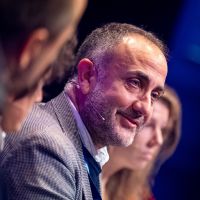 With the project STRADA, the conversation moved on to women in manufacturing. Victor Alonso presented the programme which has created a community of mentors and mentees with the aim of supporting women in manufacturing. With manufacturing still being a traditionally male environment, those women who made it into the domain needed support to become role models for generations following them. Gerard Dominguez supported the ideas of role models and said that girls got too little exposure to female leaders in technological fields, and that they needed to see more people like themselves in these roles to actually enter the STEM fields.
With the project STRADA, the conversation moved on to women in manufacturing. Victor Alonso presented the programme which has created a community of mentors and mentees with the aim of supporting women in manufacturing. With manufacturing still being a traditionally male environment, those women who made it into the domain needed support to become role models for generations following them. Gerard Dominguez supported the ideas of role models and said that girls got too little exposure to female leaders in technological fields, and that they needed to see more people like themselves in these roles to actually enter the STEM fields.
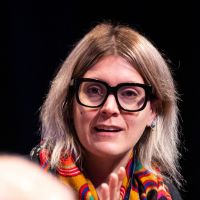 Maria Rossetti introduced the audience to the project DE4HUMAN, short for “developing design driven innovation skills for human-centred manufacturing system”. Design thinking skills are at the heart of the project which has worked with more than 100 people in eight teaching and learning factories. By bringing the human close to the machine, Maria Rossetti explained, there was a change from augmenting humans to enabling humans.
Maria Rossetti introduced the audience to the project DE4HUMAN, short for “developing design driven innovation skills for human-centred manufacturing system”. Design thinking skills are at the heart of the project which has worked with more than 100 people in eight teaching and learning factories. By bringing the human close to the machine, Maria Rossetti explained, there was a change from augmenting humans to enabling humans.
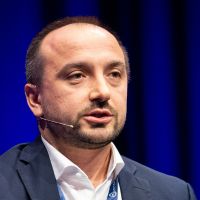 Miro Hegedic opened the audience’s minds to realising the differences in skill needs across Europe. He pointed out that new technologies are, for example, not necessarily widely known. In Croatia, 4.4% of people between 28 and 40 undergo training. In countries such as Denmark, the percentage was 60%. There simply was no content available in Croatia. He explained that equipment for teaching and learning factories could be bought with national funding. The content could not. So the project CompetenSEE seeks to provide a hybrid training course for professional training tailored to local industry demands towards Industry 4.0 readiness.
Miro Hegedic opened the audience’s minds to realising the differences in skill needs across Europe. He pointed out that new technologies are, for example, not necessarily widely known. In Croatia, 4.4% of people between 28 and 40 undergo training. In countries such as Denmark, the percentage was 60%. There simply was no content available in Croatia. He explained that equipment for teaching and learning factories could be bought with national funding. The content could not. So the project CompetenSEE seeks to provide a hybrid training course for professional training tailored to local industry demands towards Industry 4.0 readiness.
 With her start-up smartFAB, which was founded in 2018, Ann LoCicero propagates the holistic view of data from manufacturing with the aim to detect anomalies. Starting from data, they create a digital twin and mine the data for changes in real time. Humans could be integrated into the model, too, as they brought domain knowledge to the table which helped create a holistic view. Artificial intelligence, finally, generated stories to help people understand what happens.
With her start-up smartFAB, which was founded in 2018, Ann LoCicero propagates the holistic view of data from manufacturing with the aim to detect anomalies. Starting from data, they create a digital twin and mine the data for changes in real time. Humans could be integrated into the model, too, as they brought domain knowledge to the table which helped create a holistic view. Artificial intelligence, finally, generated stories to help people understand what happens.
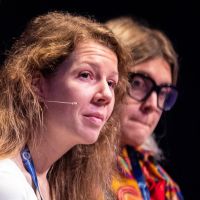 Megi Mejdrechova outlined how her start-up RoboTwin puts people at the centre of manufacturing by drawing on their knowledge but freeing their time for new tasks. For her, the robot has a particular skill, as well as the human does. But through lack of programming skills, the two cannot work together. By teaching robots through showing them what to do, Robotwin automatically creates the programme.
Megi Mejdrechova outlined how her start-up RoboTwin puts people at the centre of manufacturing by drawing on their knowledge but freeing their time for new tasks. For her, the robot has a particular skill, as well as the human does. But through lack of programming skills, the two cannot work together. By teaching robots through showing them what to do, Robotwin automatically creates the programme.
Karin Helmstaedt’s question how manufacturing could be made more attractive led to a lively conversation on stage. Miro Hegedic pointed out that manufacturing still had a dirty, hardworking image and that parents did not want their children to enter this industry. Ann LoCicero mentioned digital tools could increase attractiveness not only in manufacturing but also in service providers for the manufacturing industry.

Johan Stahre highlighted that it needed to be made clear that automation in manufacturing does not take away job, but only tasks and that this actually illustrated how human-centred manufacturing was. Maria Rossetti advocated showing the positive impact of manufacturing and also of women in manufacturing. Diana Filip suggested to let young people solve this and hand the question over to them, so that they own the quest and get involved.
For successful re-skilling and up-skilling in manufacturing, two aspects were required from Fredrik Elieson’s point of view: individuals and leadership. Individuals needed to be curious and take opportunities. And leaders needed to take the lead, as there were not enough people to perform the news tasks, the existing workforce would need to take over.
Outlook
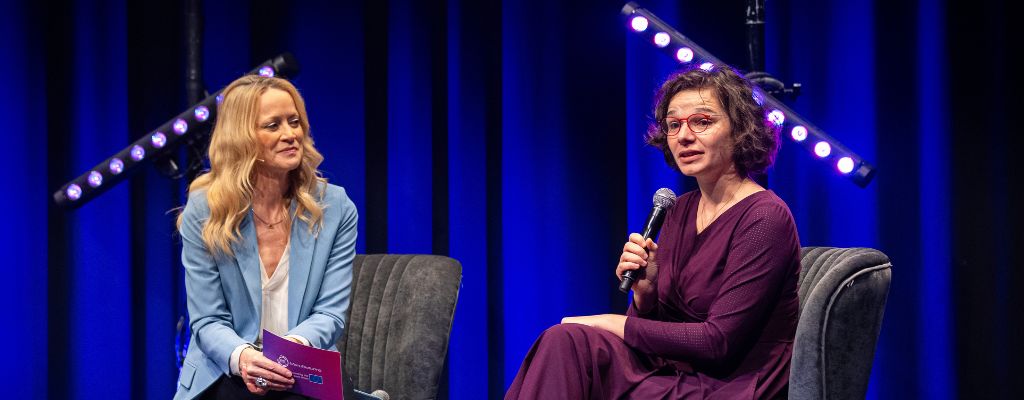 In her wrap-up of the EIT Manufacturing Summit, Caroline Viarouge put the conversation on skills into the context of the manufacturing industry as one of the basis for prosperity in Europe. With the challenges and complexities there are, “sometimes we have the feeling that we are behind, but this is not true: 25% of the world’s manufacturing output comes from Europe.” She also pointed to the amazing basis that Europe had to move forward from.
In her wrap-up of the EIT Manufacturing Summit, Caroline Viarouge put the conversation on skills into the context of the manufacturing industry as one of the basis for prosperity in Europe. With the challenges and complexities there are, “sometimes we have the feeling that we are behind, but this is not true: 25% of the world’s manufacturing output comes from Europe.” She also pointed to the amazing basis that Europe had to move forward from.
“Everyone should go home with a clear vision that what we need to work on is to be prepared to learn the right competences and to explore automatisation. We should not be scared of it, but embrace it. We need diversity, we need women, men, people from different backgrounds.”
Picture Galleries
A lot happened at the EIT Manufacturing Summit 2023 – let images speak!
Related articles
The EIT Manufacturing Summit 2023 did not only see roundtables on the main stage, but also several other activities – find out more in the articles below!

